Turn Fall Beaufort leaves to gold
Turn Fall leaves to gold by composting this year!
Anyone who writes off composting as some complicated task for turning food and yard scraps into organic mulch that hippies use to make themselves feel better should reconsider. Composting is no longer just for the farmer with acreage but also a mainstream experience for the smart suburbanites and city-dwellers. Think of it instead as a free lifetime supply of premium organic soil fertilizer.
The truth is that composting is a natural process that requires hardly any effort from the gardener. The result is a chemical-free soil fertilizer that resists erosion and enhances moisture retention in the sandy soils of the area. An added bonus: the organic matter in compost is actually feeding microorganisms, which in turn produces nitrogen, phosphorus, and potassium—all of the major plant nutrients. This will keep the soil balanced and healthy without the need for any soil additive.
It’s sort of like the difference between eating fresh ingredients in a well-balanced meal and taking a multivitamin with a Big Mac. Sure, plants are going to respond vigorously to chemically enhanced bags of soil fertilizer from the store. However, compost fertilizer improves soil fertility, stimulates healthy root development and promotes robust, longer-term nutrition for plants. The best part—it costs nothing to throw away scraps in a composting bin rather than a trash bin.
A study conducted by the Environmental Protection Agency (EPA) called “Food Loss and the American Household” revealed that “American households throw away 14 percent of the food they purchase;” and, Food Production Daily estimates that “an average family of four tosses out $590 a year in meats, fruits, vegetables, and grain products.” Think about what an extra $590 in the pocket can buy; organic waste is a valuable resource.
When potato skins, apple cores, and last week’s newspaper end up in a landfill, not only are their nutrients not being recycled to the ground, but they’re releasing a methane by-product, which is a potent greenhouse gas that damages the Earth’s atmosphere. Composting, on the other hand, produces plant nutrients as a by-product.
Many people burn piles of autumn leaves from the yard, but composting is an alternative that doesn’t risk fires, pollute the air or contribute to landfill crowding. Turn fall leaves to gold by either buying a compost tumbler or making your own for less than $40. The minimalist can gather autumn leaves, yard clippings and kitchen scraps in a pile and have usable compost deep within the pile in a year and half.
However, compost can be made in as short as three to four weeks by introducing oxygen, which breaks down the matter faster. Do-it-yourself types can build their own homemade compost bin. Make a column outside with hardware cloth or chicken wire ($10-$17 at Grayco) held in place by wood or metal stakes ($1.80-$3.29). A compost tumbler is an easy and more efficient means of introducing oxygen into the compost to break down the matter. Here’s what I did to make a homemade tumbler:
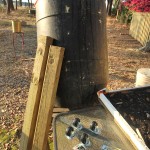 MATERIALS: I needed a big barrel. There’s a 32-gallon plastic trashcan from Grayco for $22.99, or I got this 55-gallon food grade barrel from Kyle and Marion of Rainy Day Barrels for $27 (five or more barrels are $24 a pop). The Rainy Day Barrel is exactly what I’m looking for with lots of volume and a top that screws on tightly. (Call Marion for a barrel at 843-870-1353 or Kyle at 843-870-7292). I used two wood posts that we had in the backyard. I bought four wheels, hinges, a door latch and some screws.
MATERIALS: I needed a big barrel. There’s a 32-gallon plastic trashcan from Grayco for $22.99, or I got this 55-gallon food grade barrel from Kyle and Marion of Rainy Day Barrels for $27 (five or more barrels are $24 a pop). The Rainy Day Barrel is exactly what I’m looking for with lots of volume and a top that screws on tightly. (Call Marion for a barrel at 843-870-1353 or Kyle at 843-870-7292). I used two wood posts that we had in the backyard. I bought four wheels, hinges, a door latch and some screws.
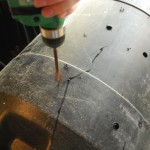
I drilled holes into the barrel to introduce oxygen to the compost while trapping the heat needed to break down the organic matter. Make sure to leave a spot for the door.
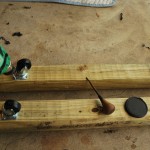
Next I drilled some wheels onto my wood posts. I’ll be able to aerate the compost each day by rolling the barrel once or twice.
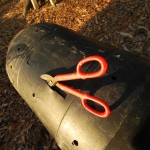
This was the most cumbersome step—cutting a rectangle for the door. I used a combination of these scissors, an Xacto knife and a saw.
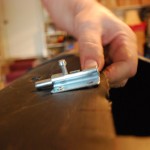
I attached a latch and hinges to make a door. This way I can open the door and add my compostable materials.
And that’s how I made my very own compost tumbler. I was inspired by this sheila’s video:
For the easy-does-it folk, I highly recommend buying a readymade compost tumbler locally from Rainy Day Barrels for $150. They also have rain barrels for $65, or two for $120.
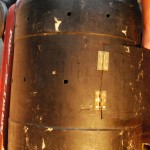
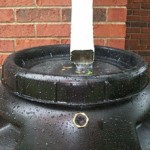
When composting remember “green, brown, air and moisture.”
Compost should be aerated and kept damp. Compost should be balanced 50/50 between green and brown materials.
“Green” is considered any vegetable or fruit part, tea bags, coffee grains and filters, grass clippings and so on; whereas “brown” includes leaves, newspapers, paper bags, egg cartons, cardboard, twigs, bark, etc… A pile that doesn’t heat up within 24 hours needs more green material (approximately 150-160F). A pile that develops an ammonia-like smell needs more brown materials. Keep out meat or fish products, cooked vegetables, dairy products, diseased plants, animal droppings, perennial weeds or weeds with seed heads. When your compost looks black and earthy, it is ready to use.
Story By Tess Malijenovsky




